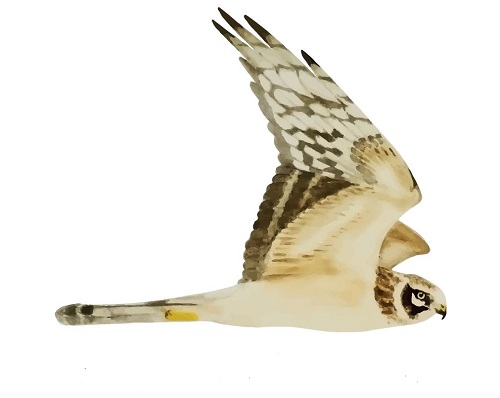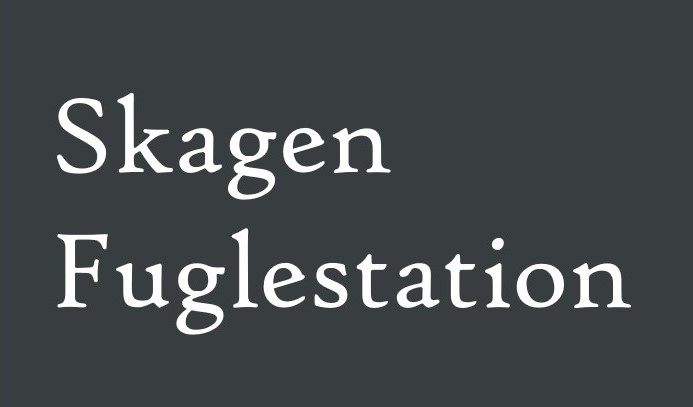Her på Skagen Fuglestations blog bringes korte nyheder i dagbogsformat om hændelser på fuglestationen.
Se indlæg fra måned: jan. (1)feb. (8)mar. (31)apr. (29)maj (30)juni (28)juli (32)aug. (31)sept. (30)okt. (31)nov. (30)dec. (8)
Popcorn og morgenobs
Bloggen starter i dag den forrige aften, hvor vi tog til det Grå Fyrs premiere på 'OS DER LEVER', hvilket handler om lokalsamfundet i Nordjylland, og hvad det vil sige at være en rigtig vendelbo. Det var en meget fin film med Niels Hausgaard som speaker. Desuden var det en Open Air Bio, hvilket betød vi sad udenfor, og derfor gæstede regnen os en gang i mellem, men det gjorde intet, fordi cafe Blink sørgede for varme tæpper og Det Grå Fyr for nogle gode popcorn. Jeg tror Bjørn spiste tre poser.
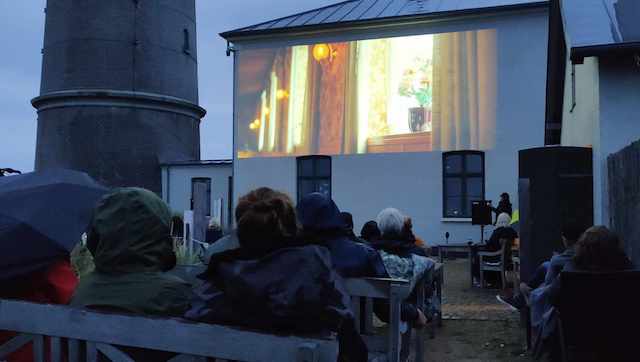
Men nu tilbage til dagen i dag, hvor vi alle sammen tog ud til Verdens Ende, og igen i dag havde vi ikke det store antal, men tilgengæld havde vi rigtig gode fugle. I dag så vi nemlig Lille Kjove og en rastende Hvidnæbbet Lom, som var dagens helt store højdepunkter.
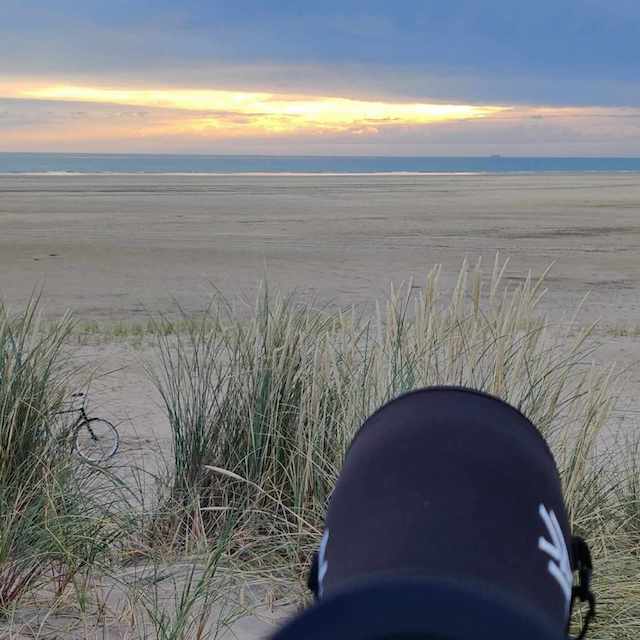
Efter morgenobsen inviterede vores gæster Kristine og Jan os til en fælles morgenmad med deres søn og hans kæreste, fordi det var deres sidste dag på stationen. Det var lige hvad vi havde på for. Det var super hyggeligt og meget værdsat. De satser stærkt på at vende tilbage til stationen næste år.
Senere hen på dagen valgte Bjørn og Jeg endnu engang at spille Klask. Det er vi blevet helt vild med her på stationen, og det spil kan varmt anbefales. Jeg plejer jo som regel at vinde, men denne gang var han heldig og vandt en enkelt omgang.
Senere hen på eftermiddagen kom vores nye gæster Stig og Grethe. De ser frem til at få sig nogle gode måltider med fisk fra egnen og være med til ringmærkningen af fugle.
Ingen ringmærkning i dag.
People: Hayley Land, Gustav Nyberg, Rebecca Cheape, Simon Kiesé, Bjørn Laursen, Simon S. Christiansen, Lisa Vergin, Kristine og Jan Hjort Christensen, Stig og Grethe
A link to today's observations from volunteers and local observers.
Counting Cormorants
This morning we started early again in Grenen for the migratory bird survey. There was hardly any bird migration to be seen today either, so we had to settle for a Great Skua (Stor Kjove) and an Arctic Skua (Almindlig Kjove), just like yesterday. As luck would have it, right after we missed Grenen.
Meanwhile, the other group of us counted the Cormorants (Skarv) at the harbour. About 900 birds were on site and over 200 of them were staying close to the fishing nets. Shortly after sunrise, however, the fishing boats arrived, whereupon the cormorants flew away. Afterwards it was quite quiet. But the Razorbills (Alk) in the harbour basin were very nice to watch. On the way back, we stopped in Fyrbakken and looked at the old fire corb.
At noon we left for the next cormorant survey. Now there were even more than 1100 birds here. It's exciting what kind of data we have been able to collect so far. Afterwards I analyzed the NocMig recording. There was hardly anything going on, as you can see from the trektellen link below.
Since there was not much to do overall, we started playing games again, like Klask. This is also an important and fun part of station life.
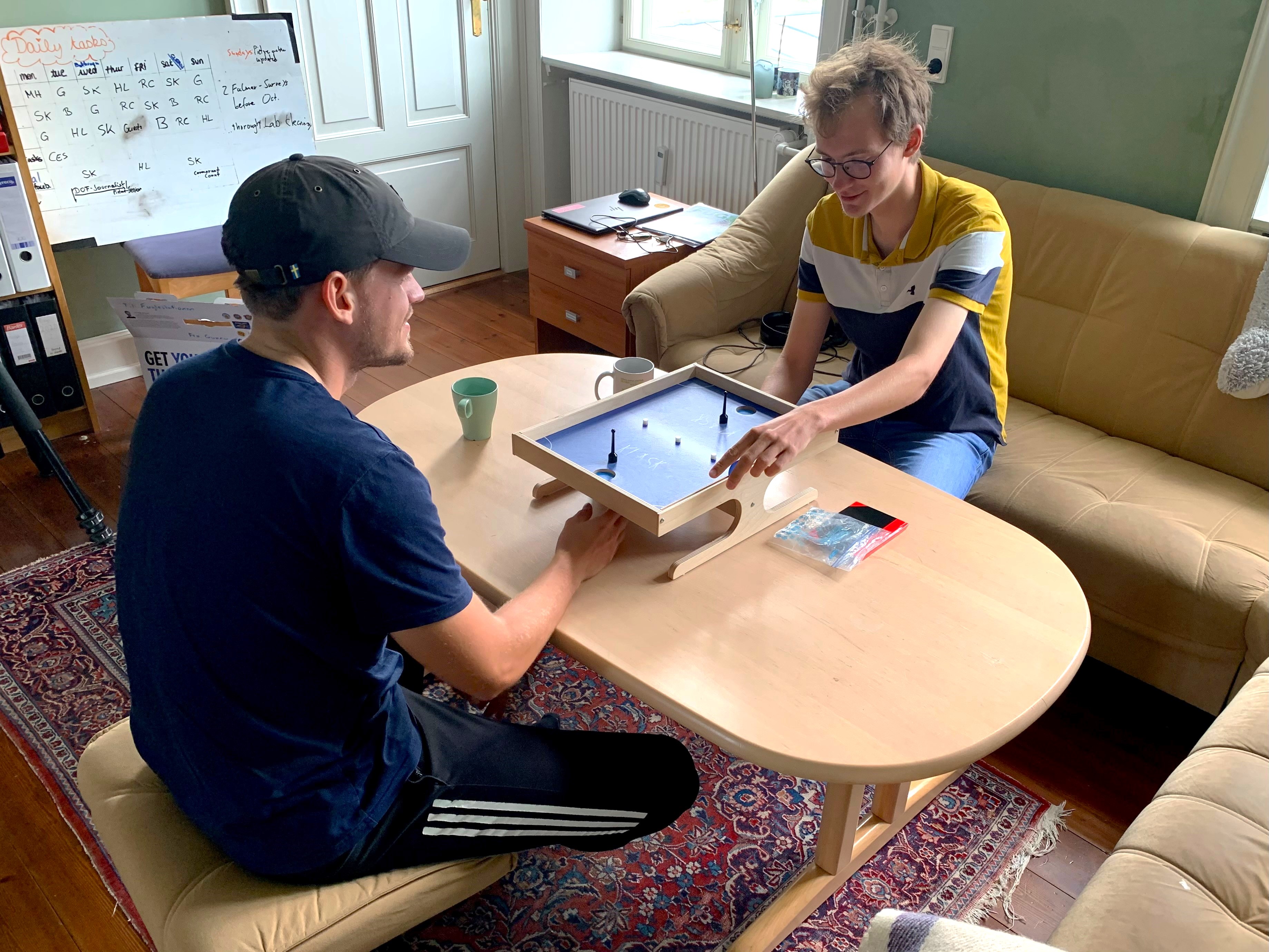
People: Hayley Land, Gustav Nyberg, Rebecca Cheape, Simon Kiesé, Bjørn Laursen, Simon S. Christiansen, Lisa Vergin, Kristine og Jan Hjort Christensen
A link to today's observations from volunteers and local observers.
A link to the results of the latest NocMig-Recordings on Trektellen.
Birds, Sunrises and Flowers
I just arrived in Skagen on Wednesday but very late in the evening, about 8.30pm, therefore, I spent all of Thursday exploring the local area. I am loving it here already as the sand dunes are blooming with beautiful purple heather, sea buckthorn, harebells, scabious and lots more! Also, EVERYWHERE I look there are just so many different species of birds that I have not seen before, so my time here is off to a great start.
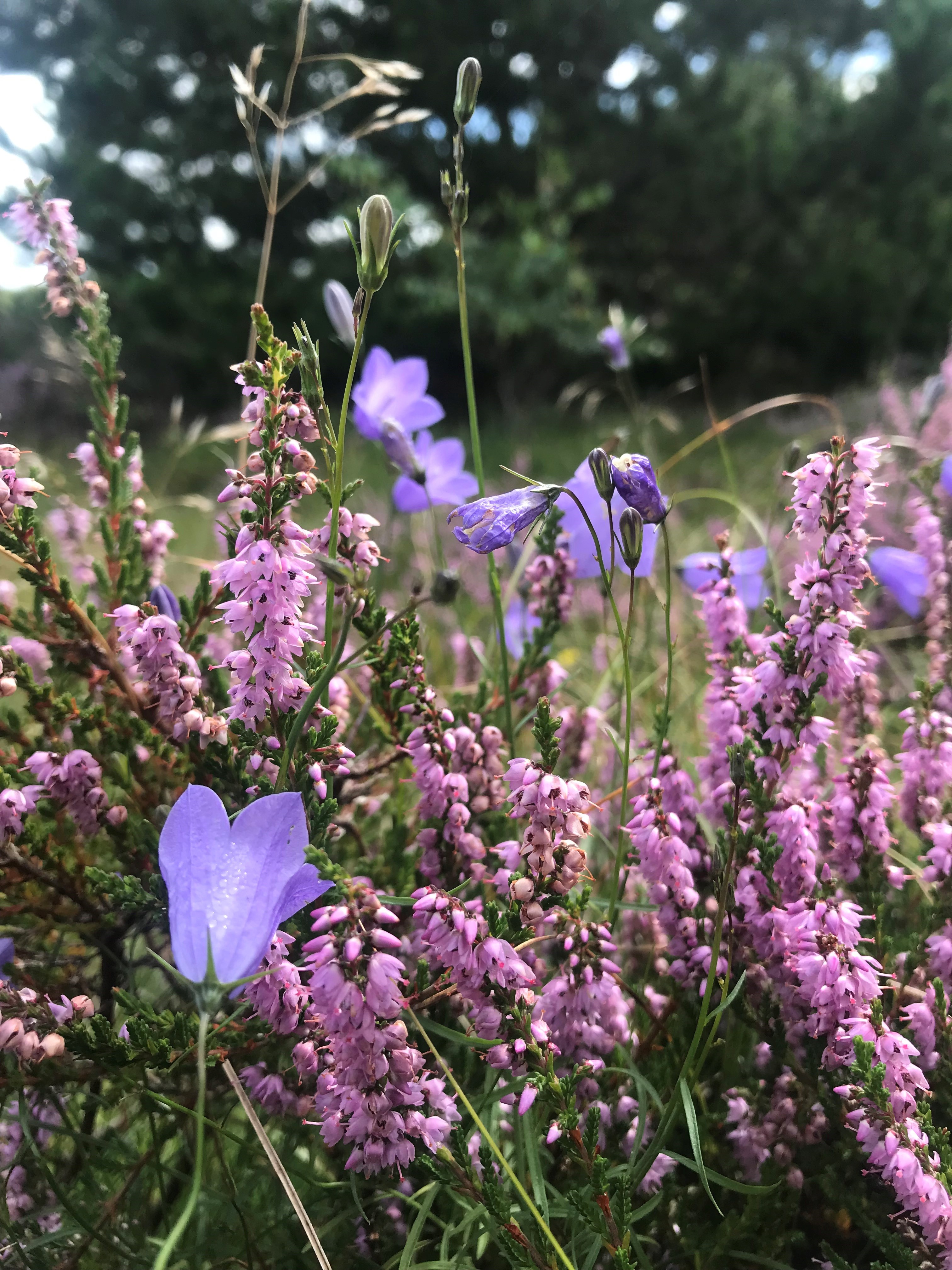
As Simon left yesterday to go to some other site to bird ring for a few days, there was not a lot on the agenda today (even though it would have been great weather for bird ringing). All five of us and Jan the guest left at 5.20 am this morning with the scopes to do the bird migration counts at World’s End Three. The migration was slow, however, it was a great experience for me doing a migration count in Skagen. There were many roosting Gulls and flying Gannets at the beach. It was a very nice morning as the weather was calm and a lovely sunrise was witnessed. There were two woodpeckers at the beach flying around the sand dunes. I love their calls.
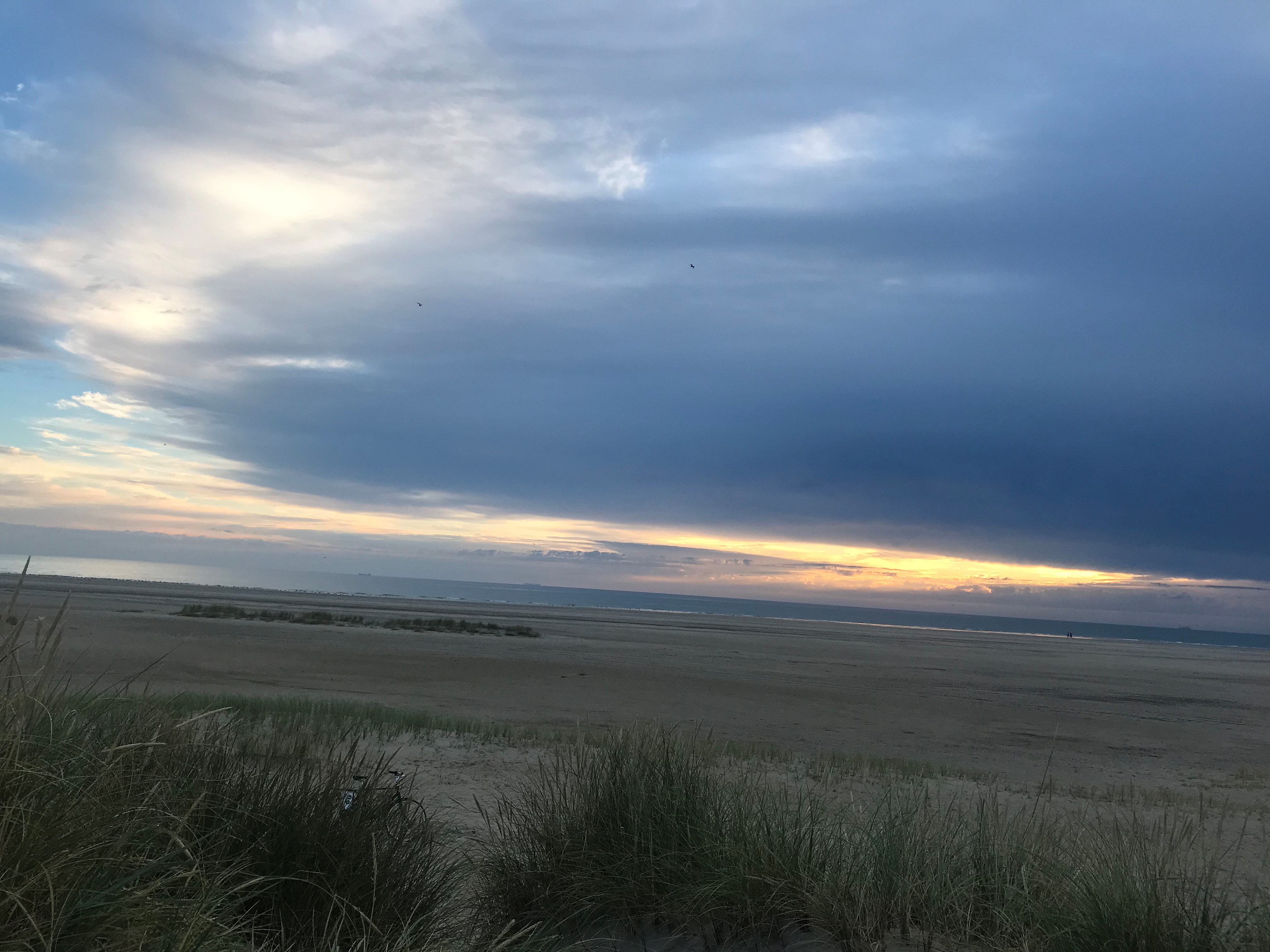
Once we all returned to the station after the migration counts, we ate breakfast and then cleaned up the station. There was nothing planned for the afternoon in relation to birds, so we all did our own thing. I went on a very long walk across the sand dunes which are covered in heather and through the woods to listen and look out for some birds. I heard several blue tits and found some very cool mushrooms growing along the woodland path. We all had a very tasty dinner made by Bjorn and then we all sat down to watch an old documentary about birds.
People: Hayley Land, Gustav Nyberg, Rebecca Cheape, Simon Kiesé, Bjørn Laursen, Simon S. Christiansen, Lisa Vergin, Kristine og Jan Hjort Christensen
A link to today's observations from volunteers and local observers.
Cormorants and Divers
Early this morning I set off on my first visit to World’s End Three to do the migration count with Knud and Jan. It was a beautiful calm day and although the migration was slow, I really enjoyed the experience and learnt a lot of new things about migration. We saw some good birds including several Arctic Skuas (Almindelig Kjove) and two Great Skuas (Stor Kjove). I really liked seeing the Velvet Scoters (Fløjlsand) but the most exciting spot of the morning was a White-billed Diver (Hvidnæbbet Lom). This is the largest species of diver found here and has a very striking plumage.
Meanwhile, Simon (junior), Gustav and Bjørn were doing Cormorant (Skarv) counts at the harbour with Simon (senior). This is for a new project which will look into the effects of shooting Cormorants in the harbour by recording their numbers and movements before, during and after the shooting. It will also help determine any long-term effects and effects on other species. Karina also joined the Cormorant count. She has now finished researching for her article on the bird observatory for DOF magazine and is leaving later today.
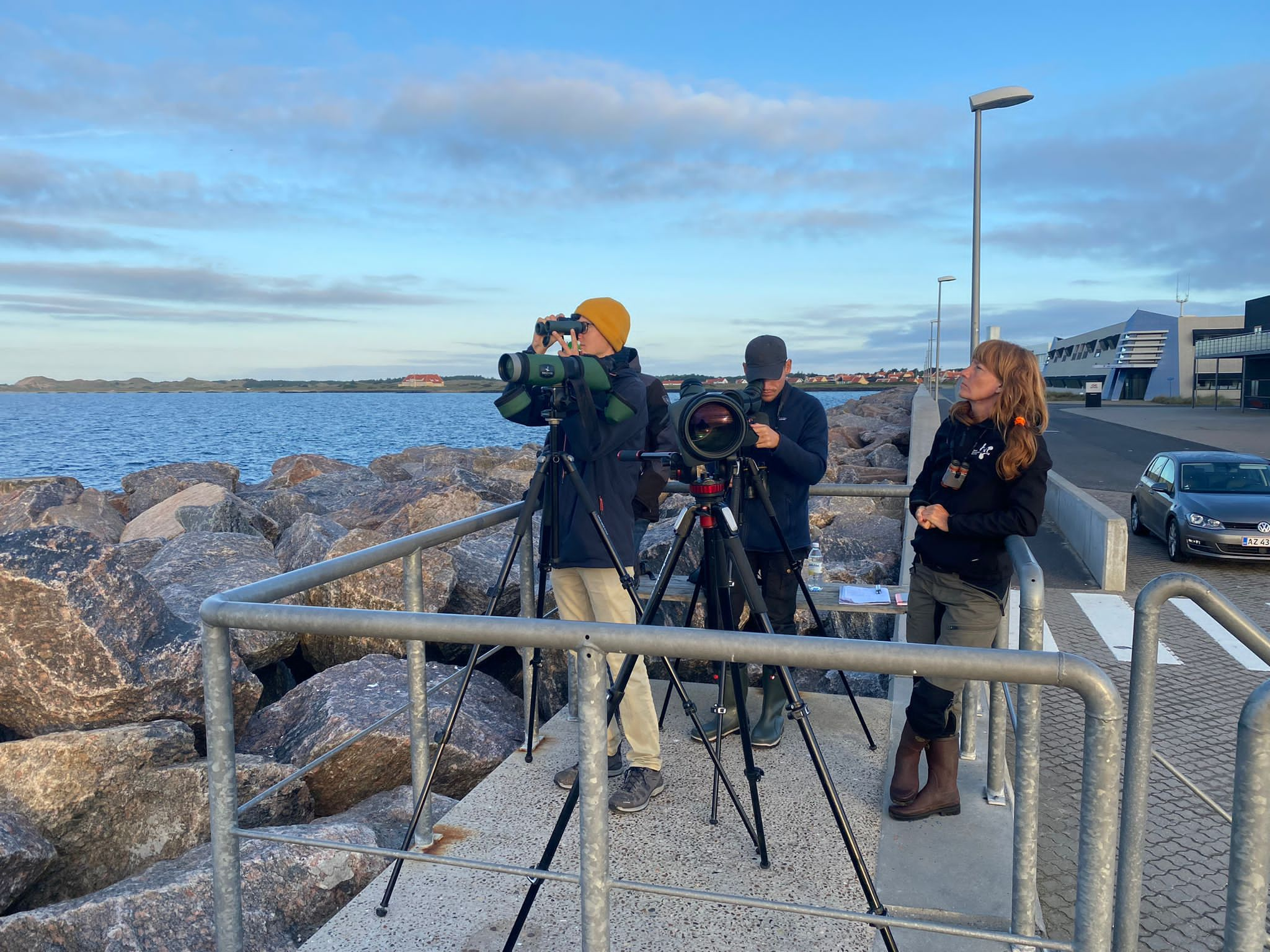
The sighting of the White-billed Diver (Hvidnæbbet Lom) was put out over Zello and Simon (junior), Gustav and Bjørn came at top speed to World’s End Three to see it. Luckily, they made it in time and were rewarded with some great views of the bird. It has been a day of divers with Red-throated Divers (Rødstrubet Lom) and Black-throated Divers (Sortstrubet Lom) also seen from World’s End, and a Great Northern Diver (Islom) spotted in the harbour.
In the afternoon, Gustav, Bjørn and I returned to the harbour to complete another Cormorant (Skarv) count. Data was entered, the evening meeting held, and we were cooked a delicious meal by Jan and Kristine, the guests in the apartment. Our newest volunteer Rebecca arrived last night and has spent the day settling in and learning where everything is. She is from Scotland and would love to see Bluethroat (Blåhals) during her time at here. Fingers crossed!
People: Hayley Land, Gustav Nyberg, Rebecca Cheape, Simon Kiesé, Bjørn Laursen, Simon S. Christiansen, Lisa Vergin, Kristine og Jan Hjort Christensen, Karina Demuth
A link to today's observations from volunteers and local observers.
Fluesnapper - I am learning the danish bird names
This morning Hayley and I packed up the ringing gear and went to Kabeltromlen to open the nets. After the first round, Simon (the first) joined us and we had a visit from our guests and Karina, who is writing an article about us for DOF magazine. It was quite wet and also because of the wind there were hardly any birds in the area. After four hours we had just 14 birds. But we were very happy to see a Spotted Flycatcher (Grå Fluesnapper) and a Pied Flycatcher (Broget Fluesnapper). Along the way, we played the game "I am a migrant" with Simon to learn moulting strategies. After we closed the nets again, we rebuilt the tent to be able to store our materials in the dry in the future. Back at the lighthouse I showed Hayley the exhibition downstairs and we went up the lighthouse.
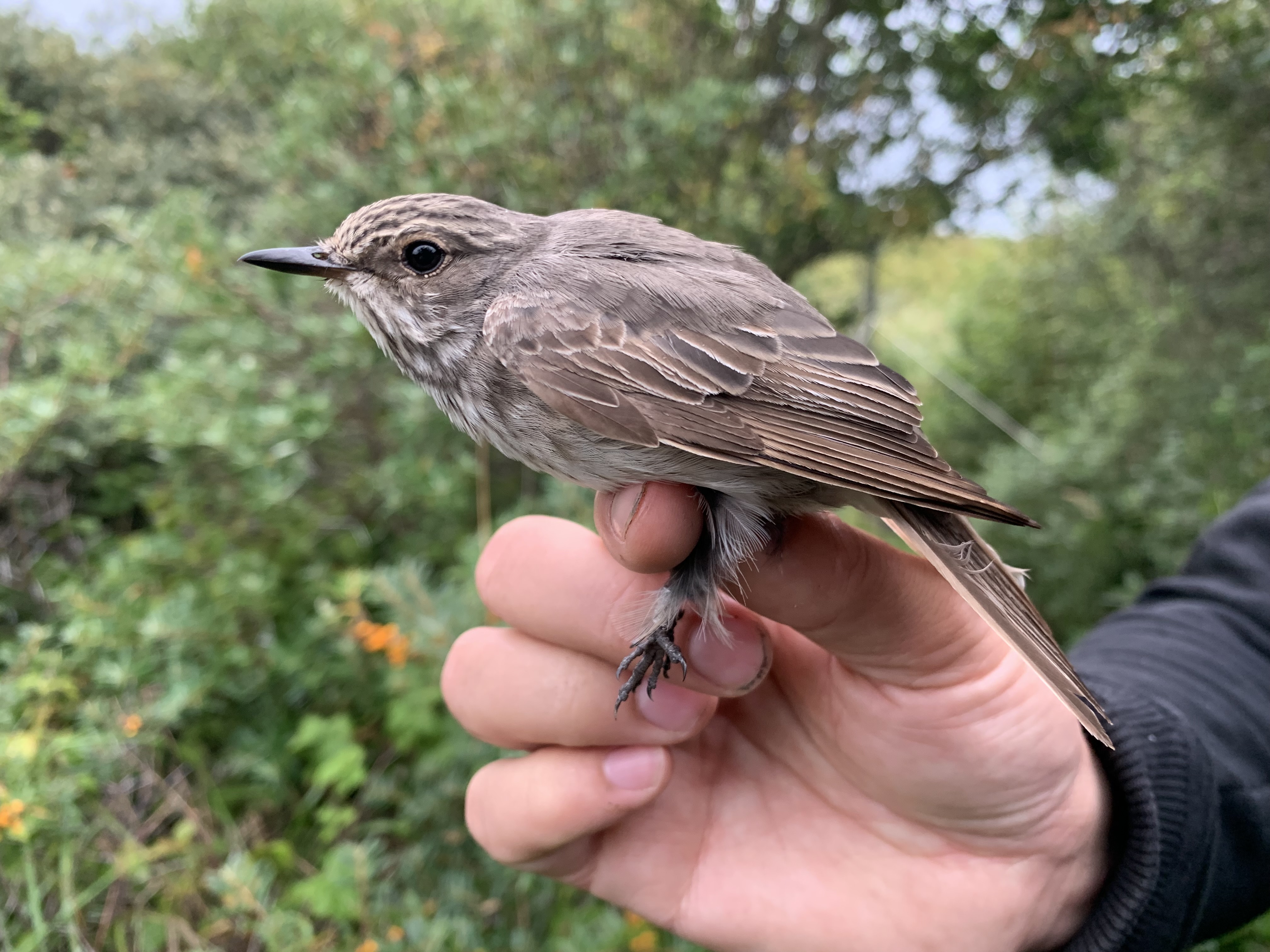
In the meantime Bjørn and Gustav were at World's End 3, watching some waders (Ryle), but also 2 Arctic Skuas (Almindelig Kjove) and 6 Great Skuas (Stor Kjove). Knud again shared his vast knowledge with us and told us many exciting things about the resting and migrating birds.
Back at the observatory there was a lot going on. Peter took care of the radio telemetry and Bjørn and Gustav were interviewed by Karina.
Now I am here at the Bird Obs for round about 3 weeks and it is really fun. The volunteers are very nice and both landscape and birds are amaying too. I think my english improved and I have already learned some danish. For example I did not look up the danish bird names for the blog. I could remember them. Is'nt that great? My brain works! Regarding to a game yesterday I have learned what to be "egget" means, but luckyly it did not happen so far, haha.
The afternoon was super productive for us. We cleaned the bathroom, cleaned the optics, went shopping, entered ringing data, updated the picture archieve and then prepared not one but two pizzas and a big salad. Tonight Rebecca, the new volunteer, arrives. Her train is a little late, but when she gets here, a vegan pizza will be waiting for her as requested.
Ringing - (Kabeltromlekrattet)
Wren (Gærdesmutte) - 2
Spotted Flycatcher (Grå Fluesnapper) - 1
Pied Flycatcher (Broget Fluesnapper) - 1
Reed Warbler (Rørsanger) - 4
Garden Warbler (Havesanger) - 1
Chiffchaff (Gransanger) - 1
Great Tit (Musvit) - 2
Reed Bunting (Rørspurv) - 2
Total: 14
People: Hayley Land, Gustav Nyberg, Rebecca Cheape, Simon Kiesé, Bjørn Laursen, Simon S. Christiansen, Lisa Vergin, Kristine og Jan Hjort Christensen, Karina Demuth, Peter
A link to today's observations from volunteers and local observers.
Nattevagt med Natravn
Dagen startede tidligt for Simon Jr. og jeg, da vi endnu en nat skulle i gang med night catching. Vi satte både natravn og stormsvale nettet op, og der gik ikke længe før vi fik 2 natravne i nettet til stor glæde for alle os på stationen, men sandelig også for de besøgende i birders club, der spændt ventede på at se hvad vi bragte tilbage til stationen.
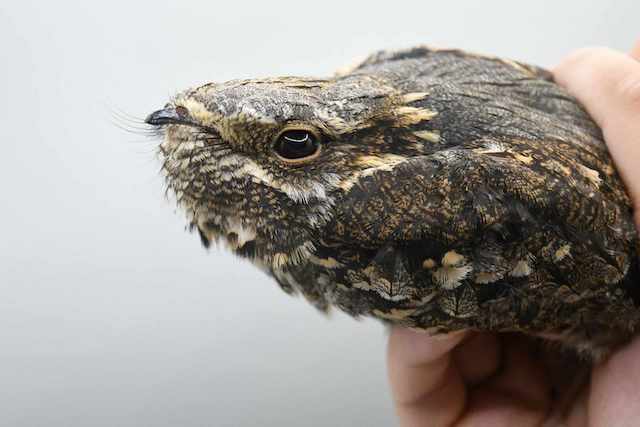
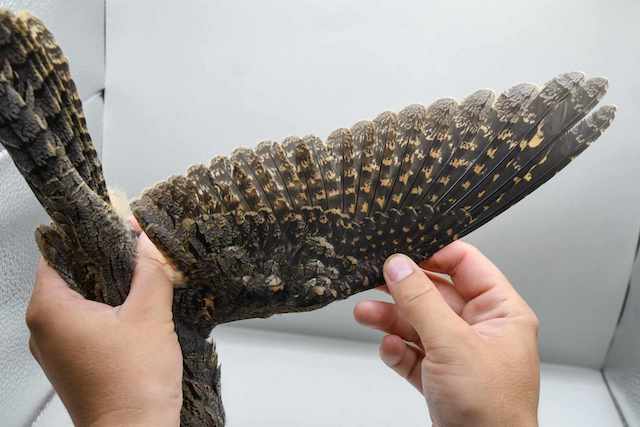
Natten bragte ikke yderligere fugle til nettene. I det Simon og jeg efter 6 timer nattevagt skulle til at gå i seng, var Bjørn på vej til verdens ende for at observere trækfugle sammen med Knud og Martina og Hayley gjorde sig klar til ringmærkning ved kabeltromlen.
Ved verdens ende blev der blandt andet set Almindelig Kjove og Storkjove, som Bjørn var meget begejstret for at se. Derudover fik Bjørn lidt tips og tricks til at spotte fugle over havet. Jan var også til morgenobservationen, og havde en god tid sammen med de andre.
Ved kabeltromlen hos Martina og Hayley var der ikke så meget gang i den, men det blev til lidt småfugle på Martinas sidste dag på stationen. Martina og hendes gode humør og evner i felten vil blive savnet her på stationen. Hun forlod os kort efter frokost, hvorefter hun skulle med toget tilbage til Tyskland. Forhåbentligt kom hun gennem Fredericia uden forsinkelser.
Simon Jr. oplærte mig og Hayley i diverse ting på stationen, sådan at vi lidt efter lidt har forståelse for at det der foregår på stationen af praktiske ting og sager.
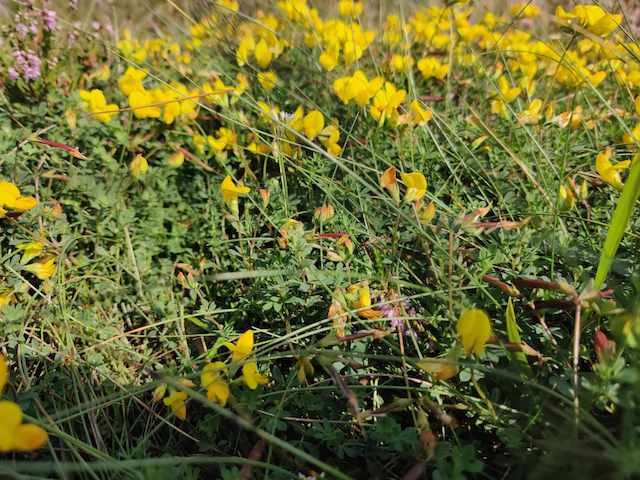
Jeg begav mig senere ud på en lille eftermiddagstur, hvor jeg skaffede mig selv lidt videomateriale til en opgave jeg har i forbindelse med mit studie. Det var alt herfra, jeg håber I har det godt derude.
Ringing - (Kabeltromlekrattet)
Gærdesmutte - 1
Kærsanger - 1
Rørsanger - 2
Gærdesanger - 1
Gransanger - 1
Musvit - 3
Rørspurv - 1
Total: 10
People: Hayley Land, Gustav Nyberg , Martina Hillbrand, Simon Kiesé, Bjørn Laursen, Simon S. Christiansen, Lisa Vergin, Kristine og Jan Hjort Christensen, Karina Demuth
A link to today's observations from volunteers and local observers.
Farewell Birds
This morning, I was woken up by the phone ringing at 2.45 am, Bjørn was calling to tell me to come to take a wader out of the net. I heard the code word “wader” and was wide awake within the second. I jogged to the net, partly because that would wake me up more, then took out the ruddy turnstone (stenvender) that was waiting for me. It was the second bird, we had caught during the night, but the nightjar was before I slept, so it counts for yesterday. The turnstone was really nice because we have been very happy to see several around on the beach in Grenen lately and I have not often handled one before. That also meant I was a bit unsure about the aging and sexing, but we just made sure to take good pictures, so Simon could help us with that afterwards. They are very cool birds, with a very cool bill and cool legs.
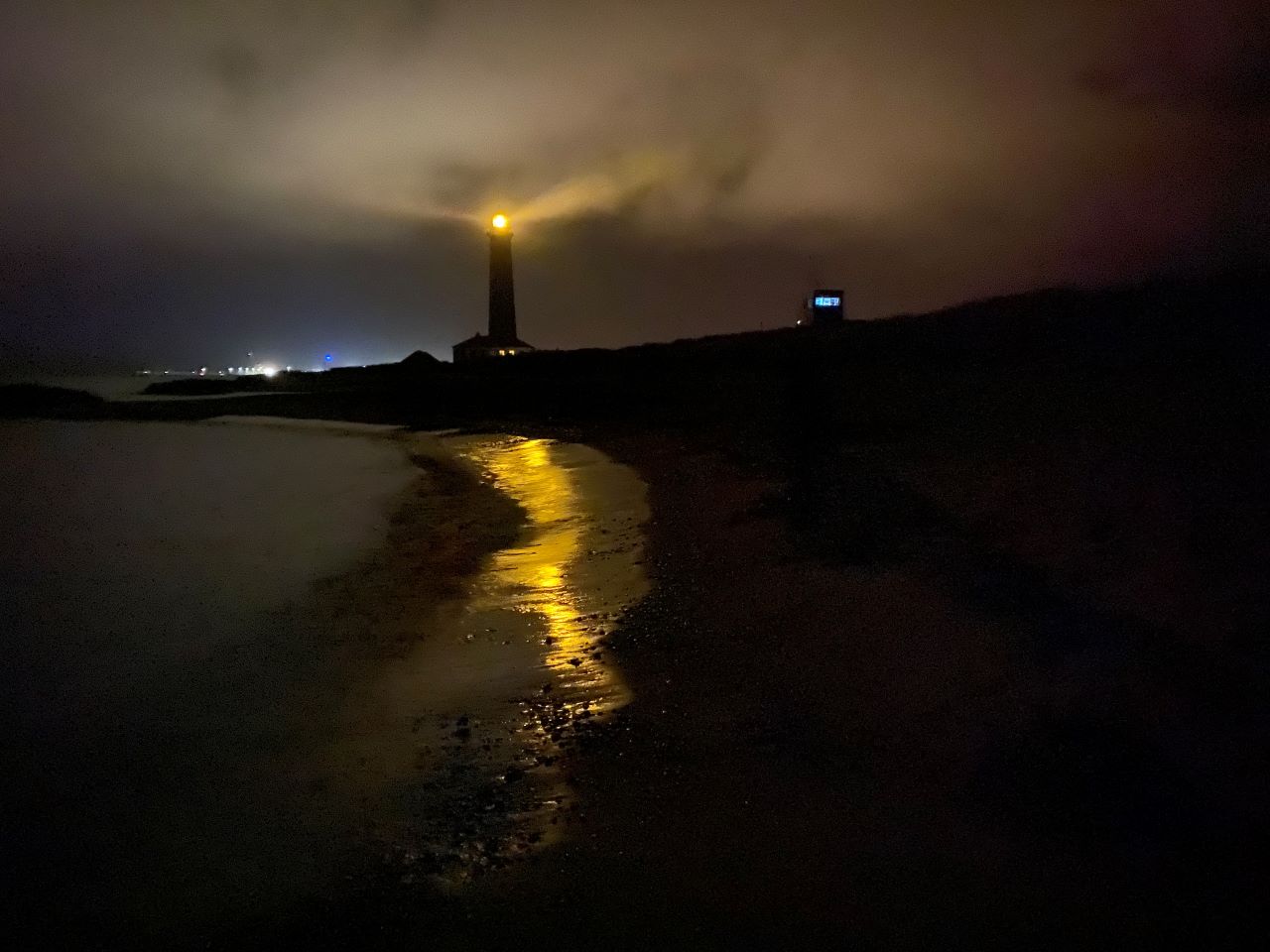
I was also getting more and more aware that my time here was coming to an end and it felt like a farewell bird that we finally caught a wader, something I have secretly wished to catch since I arrived.
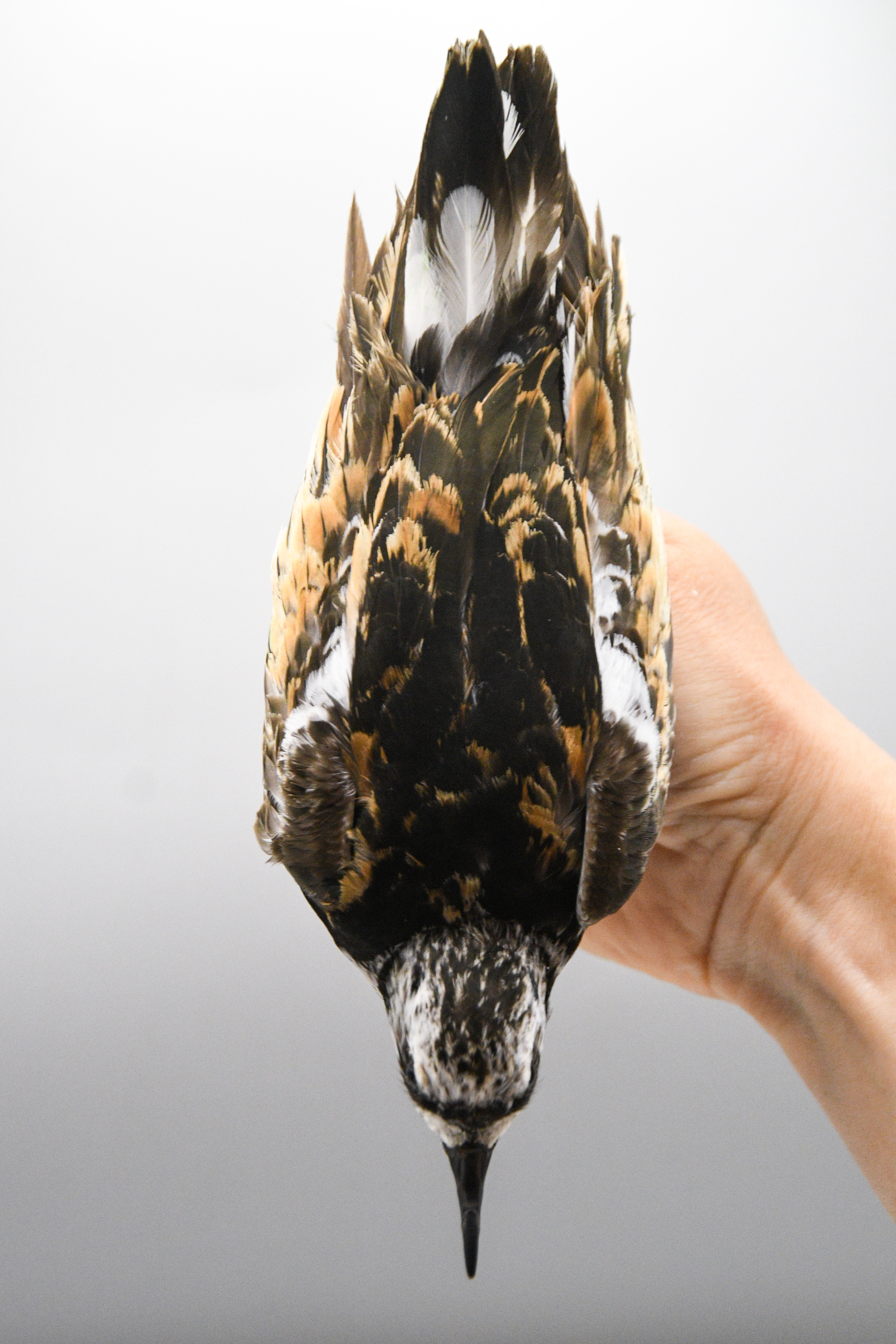
There was no time to go back to sleep, so we just had breakfast, then went all together to take down the nets and then me, Simon junior and Hayley made our way to Skarvsøen, while Bjørn and Gustav could sleep after the night watch. We arrived to set up the CES nets half an hour before sunrise and hope for as good a morning as we’d had the last two times I was there. Therefore, we were a little bit disappointed, even though the day was actually really good – especially compared to the last days at Kabeltromlen. We started off with some reed warblers (rørsanger) and then just had the “normal” birds. IT was interesting to see, however, that a lot of reed warblers must have dispersed already, since we started catching adult birds that did not have a ring on, something that very rarely happened the last couple of weeks.
Hayley got to ring her first birds and learn the measurements we are taking here. Since she has done quite some ringing before, she learned very fast. Simon the first also came to visit us later and then we had a bird that was also rather special to me: a pied flycatcher (broget fluesnapper). Flycatchers are not caught very often here, but they are very pretty and very useful birds, seeing that their main source of food are mosquitoes. I was very happy to get to see that as well, before I leave.
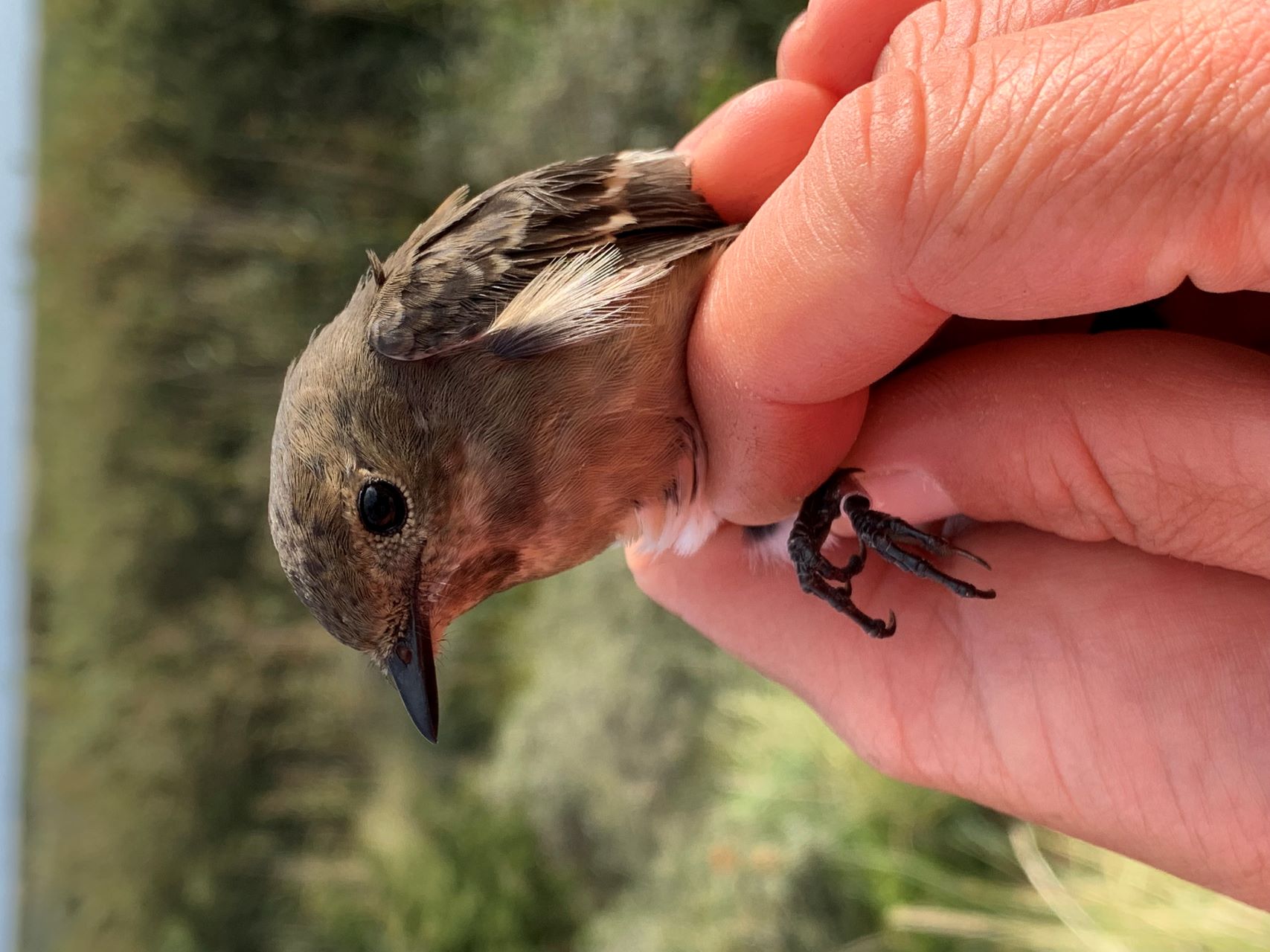
We closed the nets after the six hours and went home and slept a little, since we were not able to sleep much last night due to the night catching. Afterwards we did all the office work and then we had an evening meeting, where we finally got to really meet the new guests in the apartment (they have been here last year as well). Also, Karina from DOF arrived and joined our meeting. She will join us the next couple of days to learn about our work for an article she is writing for the Fugle magazine. Now we just hope that she also gets to see some cool birds!
While the boys are getting ready for another night of night catching, I am packing my bags to go home tomorrow, as on Monday I will start school again and I hope to still sleep a little before that. I did not have the best weather, neither the best birds this time that I was here, but it is also a very nice feeling, that, every time I come here, it feels like coming home. I know so many people here by now (probably more than I know in Hamburg after two years of living there). Even if there are not so many birds, the landscape and the very special light you get here, especially around sunrise and sunset make it always a very nice experience to stay. Also, there are always cool people you get to meet – I mean, how cool do you have to be, to decide to stay a few months at the End of the World, knowing sleep will be rare, you will go out in all weathers and you won’t have time to do “normal people stuff”, just so you can be here, watch and ring birds and learn more about birds and the environment in general? It was the fourth year I was here now, and I don’t think I will come back next summer, because I want to go to another observatory, but I do hope I will be back some time soon. It is just always an experience both to enjoy but also to learn from. It is also quite nice for many of us, that here, we are just “normal” people; back home most of us are known as very weird. It’s always nice to be among like-minded people, in short. And Skagen is just a very good place to be that, because you do get a lot of rather special birds! Thank you all, once again, for welcoming me, sharing your experiences and life stories and being part of my life for the last 4 weeks. I will, of course, try to use everything I learn here, also for my teaching in school.
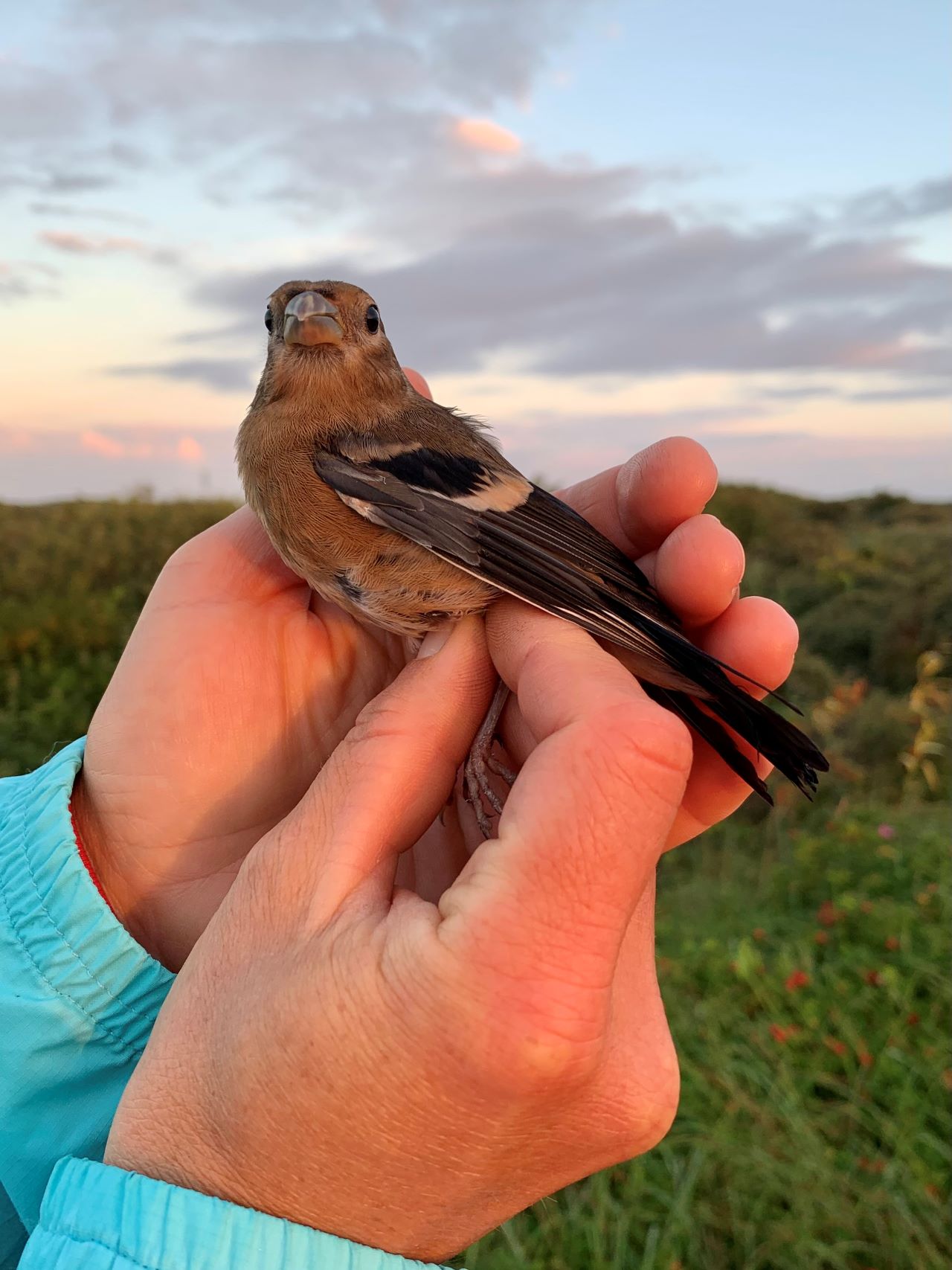
Lille Dompap (Bullfinch) in the beautiful morning light of today.
Tomorrow, I will do one more morning of ringing at Kabeltromlen with Hayley. Then I will be off. Migration will start properly on the weekend, I think, so be prepared!
Ringing (Fyrhaven)
Natravn (Nightjar) – 1
Stenvender (Ruddy Turnstone) - 1
Ringing (Skarvsøen)
Broget Fluesnapper (Pied Flycatcher) - 1
Tornsanger (Common Whitethroat) – 3
Havesanger (Garden Warbler) - 1
Gærdesanger (Lesser Whitethroat) - 2
Rørsanger (Reed Warbler) - 14
Løvsanger (Willow Warbler) - 2
Gransanger (Chiffchaff) - 4
Rørspruv (Reed Bunting) - 1
Dompap (Bullfinch) - 1
Total: 31
People: Hayley Land, Gustav Nyberg , Martina Hillbrand, Simon Kiesé, Bjørn Laursen, Simon S. Christiansen, Lisa Vergin, Kristine og Jan Hjort Christensen, Karina Demuth
A link to today's observations from volunteers and local observers.
The team is growing
I woke up this morning at the usual time to go ringing at Kabeltromlen. It was a bit weird to be on my own, but I did not expect there to be many birds (again due to rain over the sea and in the south of Sweden and Norway during the night, as well as southerly winds), so I told Bjørn he might be better off going to the migration count instead. So, I left an hour before sunrise to open the nets and was greeted by lots of mosquitos and incoming fog on the way. After opening the nets and instead of waiting for half an hour alone with hundreds of mosquitos, I walked to the beach to see what was happening there. And there was happening quite a bit (which proved me right, probably to tell Bjørn to go there instead): I saw 2 green sandpipers (svaleklire), which I have not seen in Skagen at all, I think, and at least 5 golden plovers (Hjejle) roosting on the beach, next to the usual dunlins (almindelig ryle), and lots of ringed plovers (stor præstekrave).
Either way, I could not stay to enjoy the view, since somebody had to check the nets, and seeing that I was on my own, that somebody was me. I went out and had a couple birds in the first few nets which had never caught anything in the last few weeks, so I was getting my hopes up too high, for sure. I had a nice first hour with some birds – although only local breeding birds, but then there was a long stretch of almost nothing. I finally closed the nets early after two empty net checks.
In the first net check, however, there was a rather interesting bird: a blackcap (munk). Now, you might say, they are quite common here, so not that interesting really (mind you, I think they are very underrated, seeing that they are probably the most audible of beautiful spring sounds in most of Europe), but this one was special: it had a tiger-striped head. Since most birds are now in moult (they need to change their feathers regularly, because they wear off and then are not good for insulation, and neither for flying, and just after the breeding season and before migration seems a good time for most birds – especially the ones that are not in a hurry to leave, because they are not going to the other end of the globe), seeing two plumages on one bird is not so surprising. We see it every day on the shorebirds (ryle) out on the beach, as well as in the eider ducks (ederfugl) in the sea. However, after closer inspection I found that this bird was not actually moulting. It was in completely juvenile plumage. Maybe he was friends with the baby red-necked grebes (gråstrubet lappedykker) from Skarvsøen, because they too have a striped head in their juvenile plumage.
Anyway, I did some research in the books and apparently the brown cap of juvenile blackcaps can have different degrees of light and brown dark, as well as black, in their crowns. It is just not something we see very often, and it looks really funny:
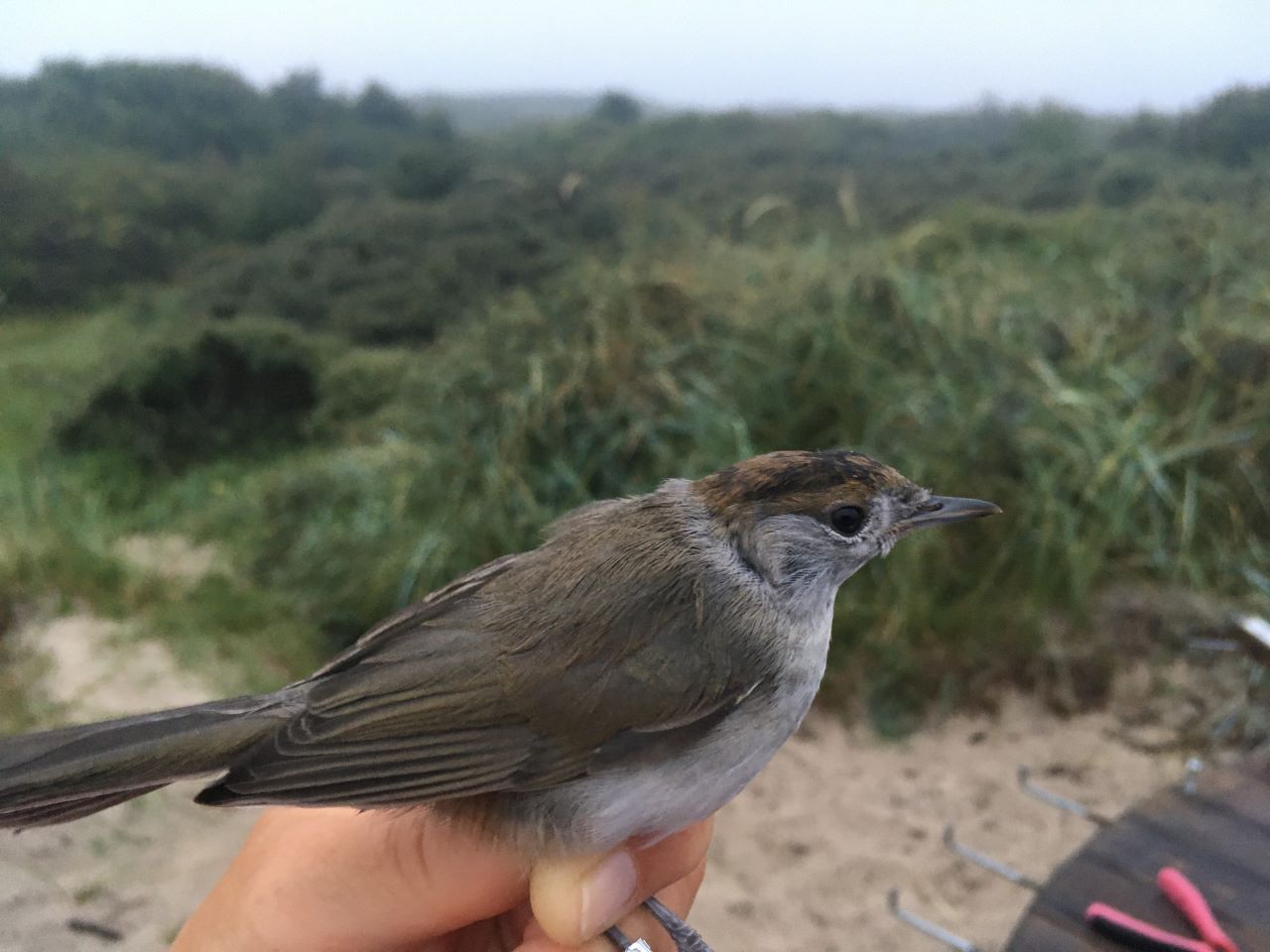
Meanwhile, the team at the observation, joined by Hendrik on his last morning, observed lots of gannets (sule) fishing on the shores, also the still present Atlantic skua (almindelig kjove), and several dozens of golden plovers (hjejle) passing. Highlight of the morning was probably an adult female red-footed flacon (aftenfalk), a species that is normally mainly seen here in the spring. Later, a merlin (lærkefalk) passed by as well.
In the afternoon, two new volunteers arrived: Hayley from England, who will stay for three months and has some years of ringing experience in England. She is hoping to see many new species in Skagen and would be delighted if she got to ring a bluethroat. And Gustav, he is Danish and has volunteered here before but only for a few days. Obviously, he liked it, so he chose to come here for his internship for his studies and will stay for more than 3 months! The autumn team is finally getting shape.
Henrik and Karen left us around noon, and two other guests will move into the apartment tonight. They were delayed on their way here, so we did not get to meet them before we went to bed, however.
Ringing (Kabeltromlekrattet)
Munk (Blackcap) - 2
Tornsanger (Common Whitethroat) - 3
Gærdesanger (Lesser Whitethroat) - 2
Rørsanger (Reed Warbler) - 1
Gransanger (Chiffchaff) - 1
Total: 9
People: Hayley Land, Gustav Nyberg , Martina Hillbrand, Simon Kiesé, Bjørn Laursen, Simon S. Christiansen, Lisa Vergin, Morten Christiensen, Kristine og Jan Hjort Christensen
A link to today's observations from volunteers and local observers.
Water rail day
This morning, I went out with Bjørn to open the nets at Kabeltromlen. We were soon joined by Simon the first, who stayed for less than 3 hours, but enough time to get some really good birds:
In the first net check – yet again! – we had a juvenile water rail (vandrikse). It was the third we ringed in the last 10 days, all caught in the same row of nets, all of them juveniles, so we assume they are brothers and sisters from one family of Water rail, that lives north of the trail. There must be another family south of the trail, because we always hear them. It is amazing, that there are so many of them, and what a great treat to get to ring them all, so we also know, it is not always the same bird that comes to us. Rails are normally very hard to see, and therefore almost impossible to count otherwise, which is also why we only have very rough estimates of how many water – and other – rails there are – in Denmark, or in Europe, or worldwide, really. This is where catching and marking birds is a very big advantage, because suddenly we see, that the birds we keep hearing actually seemed to have a good breeding success. Mind you, of course, we don’t catch all the birds around, so not having caught many in other years does not necessarily mean they had low breeding success. It might be just that this year they like to hang out around our nets for whichever reason.
In brackets: after Simon left, we caught yet another juvenile water rail, making it four total in the last 10 days!
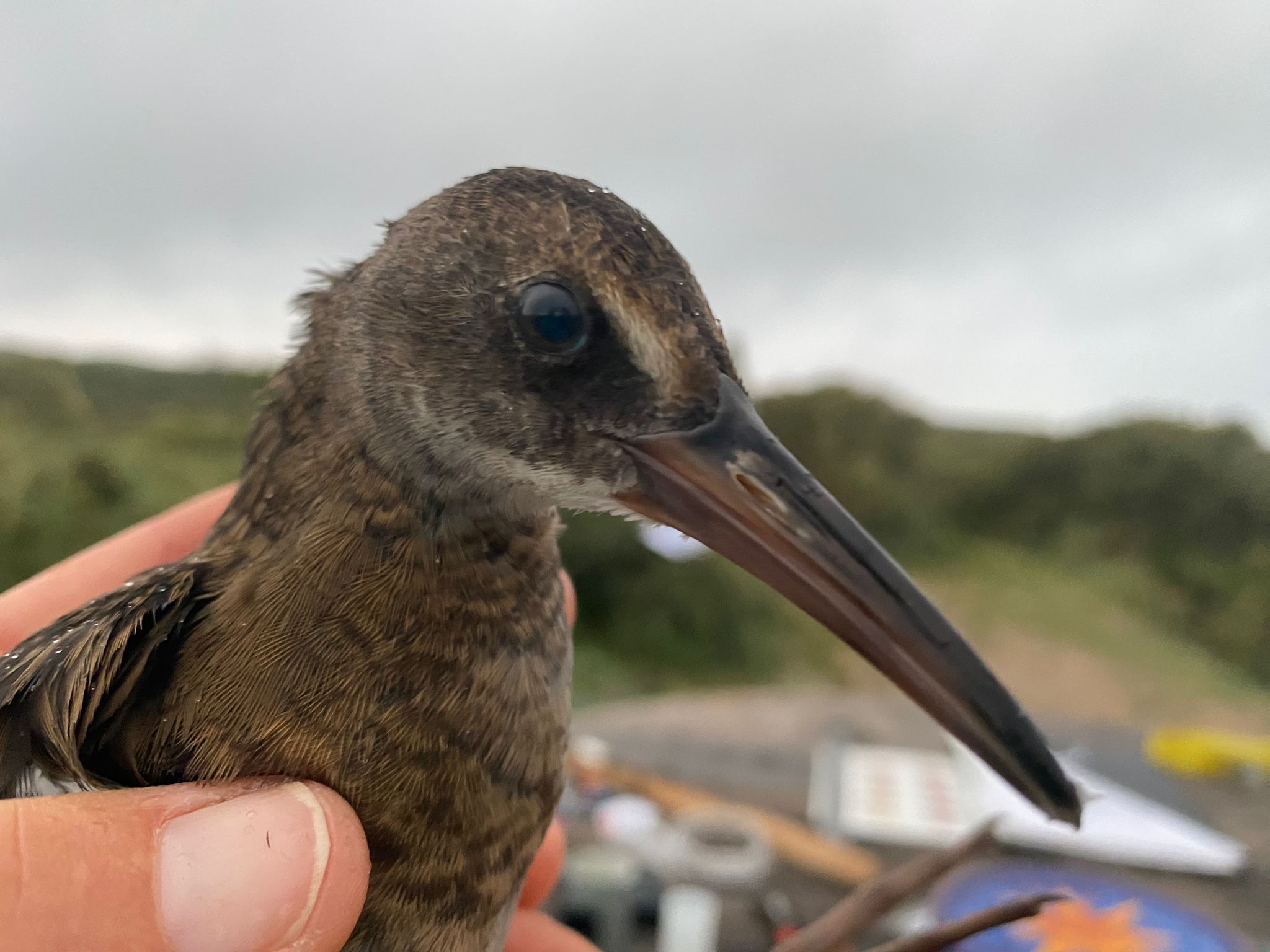
Picture of one of the water rails (vandrikse).
Before he left, however, we also caught quite a treat: a barred warbler (høgesanger). This is yet another bird that is very rarely seen, however, it is also not often heard in Denmark, simply because there aren’t many. In fact, it has not been known to breed in Denmark for the last few decades, only this year they reported one single breeding pair again. Whether or not there are more and they are just not known, we cannot really guess. Fact is, barred warblers are not common in Denmark, however, another fact is, they are not easy to observe.
Therefore, it was not so surprising that several birders who were in the close surroundings when Simon made the Zello call, came to watch the ringing and get a picture of this rather special bird.
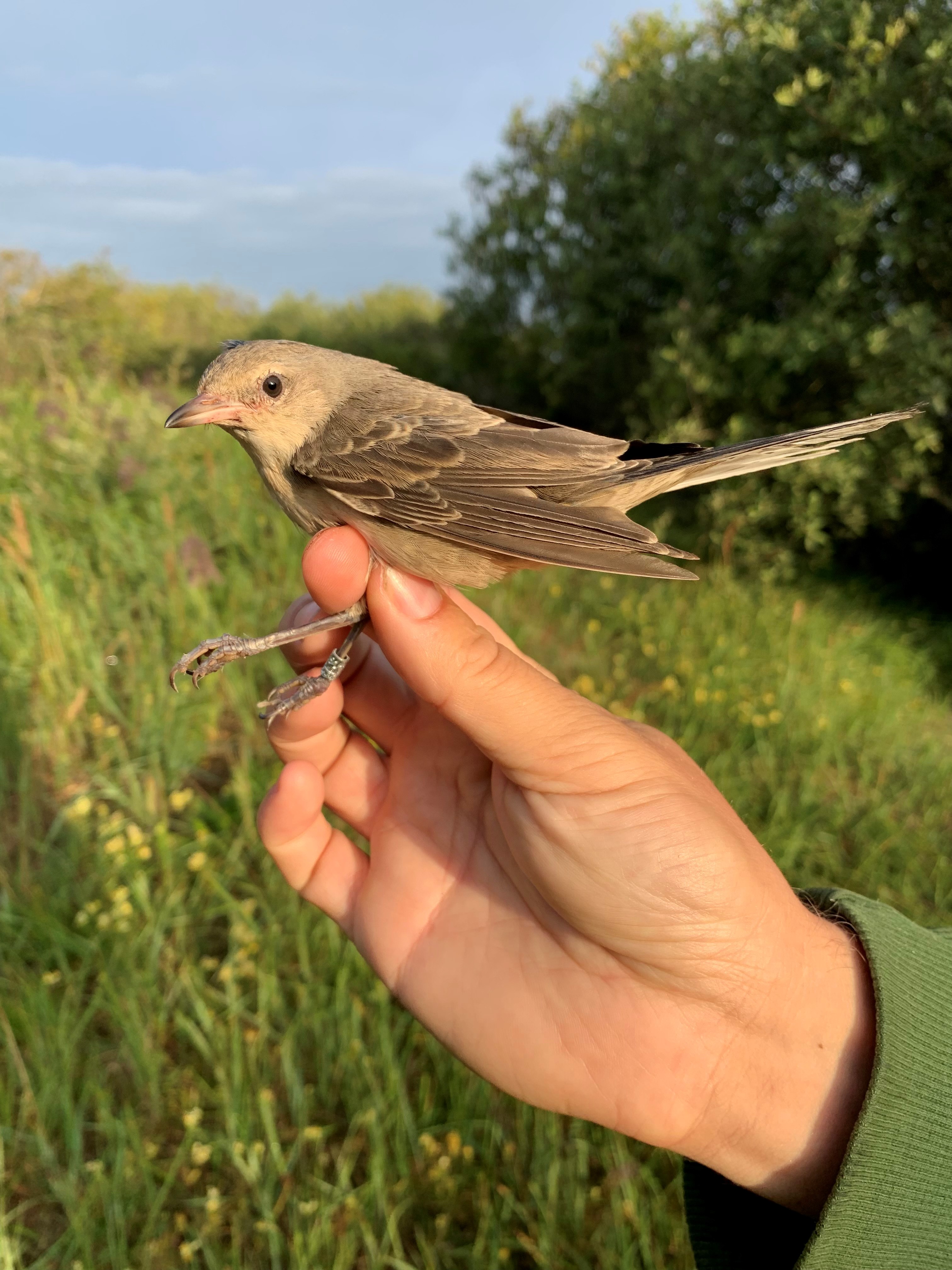
Picture of the barred warbler (høgesanger).
Not much later, the zitting cisticola (cistussanger) that has been hanging around for a while now, was heard again. This lead to an even higher influx of people with big scopes and big cameras.
Simon the first then left to do some errands, while Bjørn and I just continued our normal work. As was to be expected: In the net check after Simon left we had a rather large number of birds, so we called Simon the second to help, because he was sitting at World’s End 1 with Rolf, doing the migration count, which, again, did not produce all too many birds, so he was probably quite happy to be allowed to leave early, and get to see our 4th water rail instead.
Finally at around noon we closed down the nets after a medium successful ringing day. We had quite a few birds – more than the last few times, however, they were still mostly not what you would call “migration”. Interestingly, the last few times we almost caught no whitethroats (tornsanger), whereas today they showed up again. I do not have an explanation for that, other than the fact that some of them were caught on the south side, which we did not always have open, because I was the only licensed ringer for some days. However, even on the north side we suddenly had tornsangers again. Maybe they were hiding somewhere else during the storm and are now back. Hopefully to eat the loads of berries that are out there and prepare for a good migration, so that many of them can return and have babies next year!
Migration was there, however, in a marsh warbler (kærsanger), a willow warbler (løvsanger) and a garden warbler (havesanger). And also the barred warbler, of course. The problem with the migration thing seems to be the weather. The storm is now over, but the winds are still from the south. Also, even though we haven’t had rain here in the last few days, it has been raining a lot over the sea and in the south of Sweden and Norway, and especially during the early hours of the night when birds would start their migration. At the end of next week it looks like the winds will change and migration will probably pick up speed. However, if migration conditions are very good, birds might just pass us by completely and not stop here but go through further south if they can. We will patiently (or not so much) wait and see.
In the afternoon, we had a cleaning day and a last dinner with the guest from the apartment, who are leaving tomorrow. We hope they will come back next year!
Ringing (Kabeltromlekrattet)
Vandrikse (Water Rail) - 2
Munk (Blackcap) - 2
Tornsanger (Common Whitethroat) - 5
Gærdesanger (Lesser Whitethroat) – 1
Havesanger (Garden Warbler) - 1
Høgesanger (Barred Warbler) - 1
Rørsanger (Reed Warbler) - 3
Kæersanger (Marsh Warbler) - 1
Løvsanger (Willow Warbler) - 1
Gransanger (Chiffchaff) - 4
Rørspruv (Reed Bunting) - 4
Gulspurv (Yellowhammer) - 1
Total: 26
People: Martina Hillbrand, Simon Kiesé, Bjørn Laursen, Simon S. Christiansen, Lisa Vergin, Karen and Henrik Toft
A link to today's observations from volunteers and local observers.
Good Catches
A picture is worth a thousand words.
This is the motto of today's blog post. Except for the Water Rail, the pictures today are all mine.
Last night we opened the nets again, as usual for Nightjar (Natravn) and Storm Petrel (Lille Stormsvale). Things didn't go quite according to plan during the night, but that's another story. The night got off to a great start. At the first real net check Bjørn and I walked together to the first net and to our surprise there were two Nightjars (Natravn) hanging right there. Totally cool. Martina put a ring on the young bird (1st cy) and I on the previous year's female (female 2nd cy), then the birds were measured and weighed as usual. The age determination was easy to see, especially in direct comparison with the feathers moulted on the K2 bird. Without the comparison the camouflaged feathers look confusing, but in comparison you can see the differences. See for yourself.
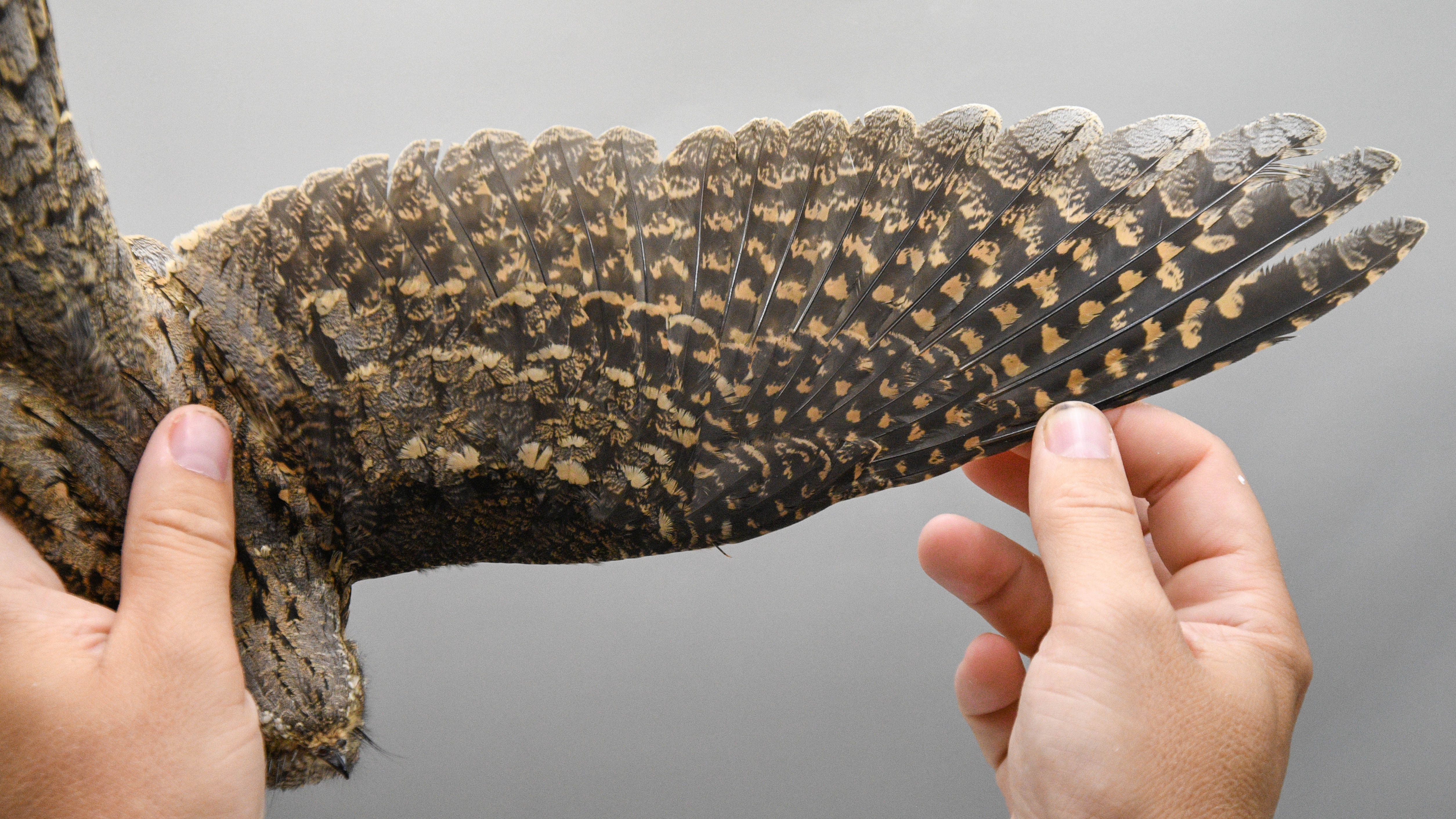 Nightjar (Natravn) - 1st cy
Nightjar (Natravn) - 1st cy
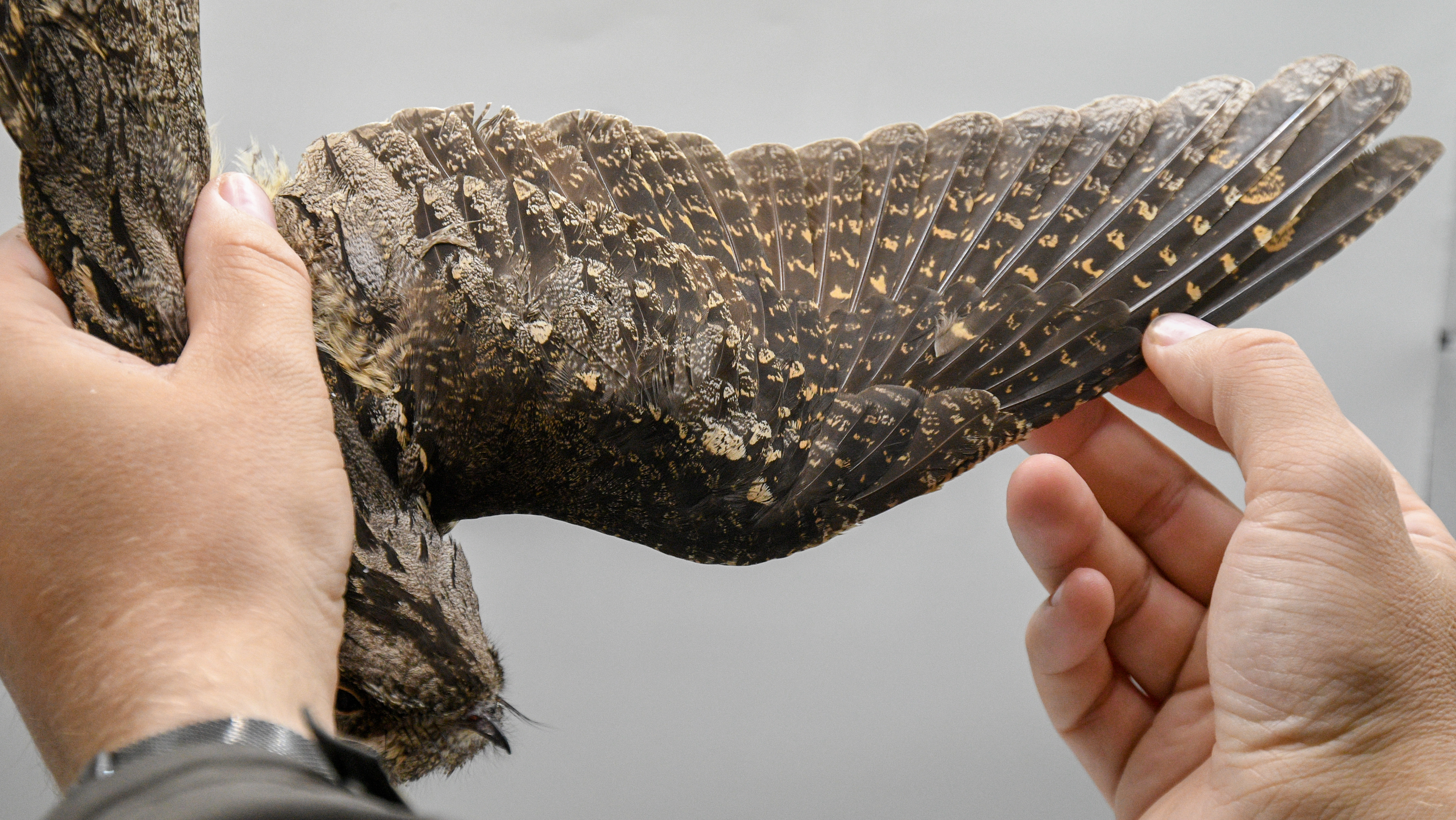 Nightjar (Natravn) - female 2nd cy
Nightjar (Natravn) - female 2nd cy
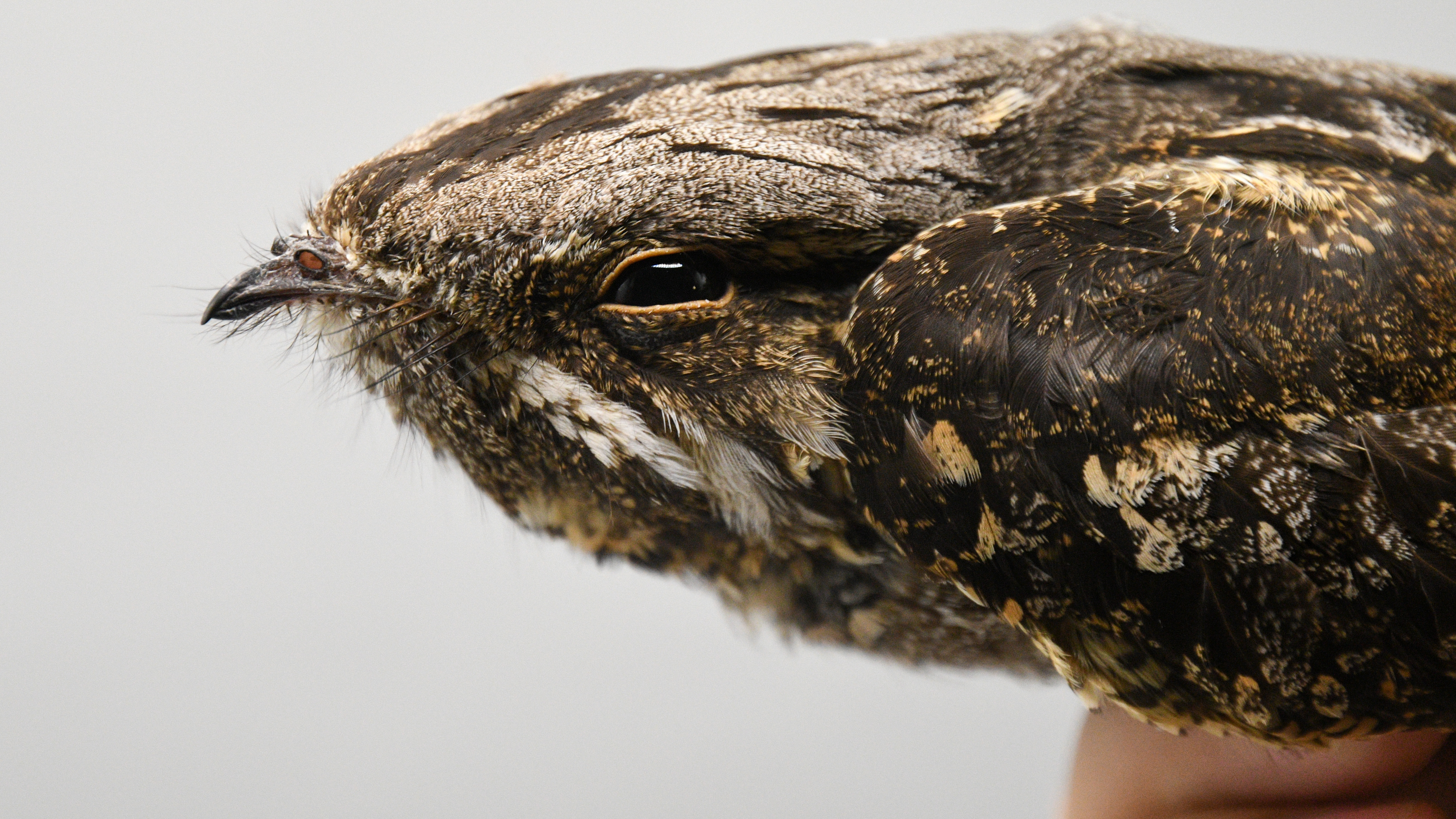
Later that night we also caught and ringed the first Tern of the year, this year's Common Tern (Fjordterne). What a successful night.
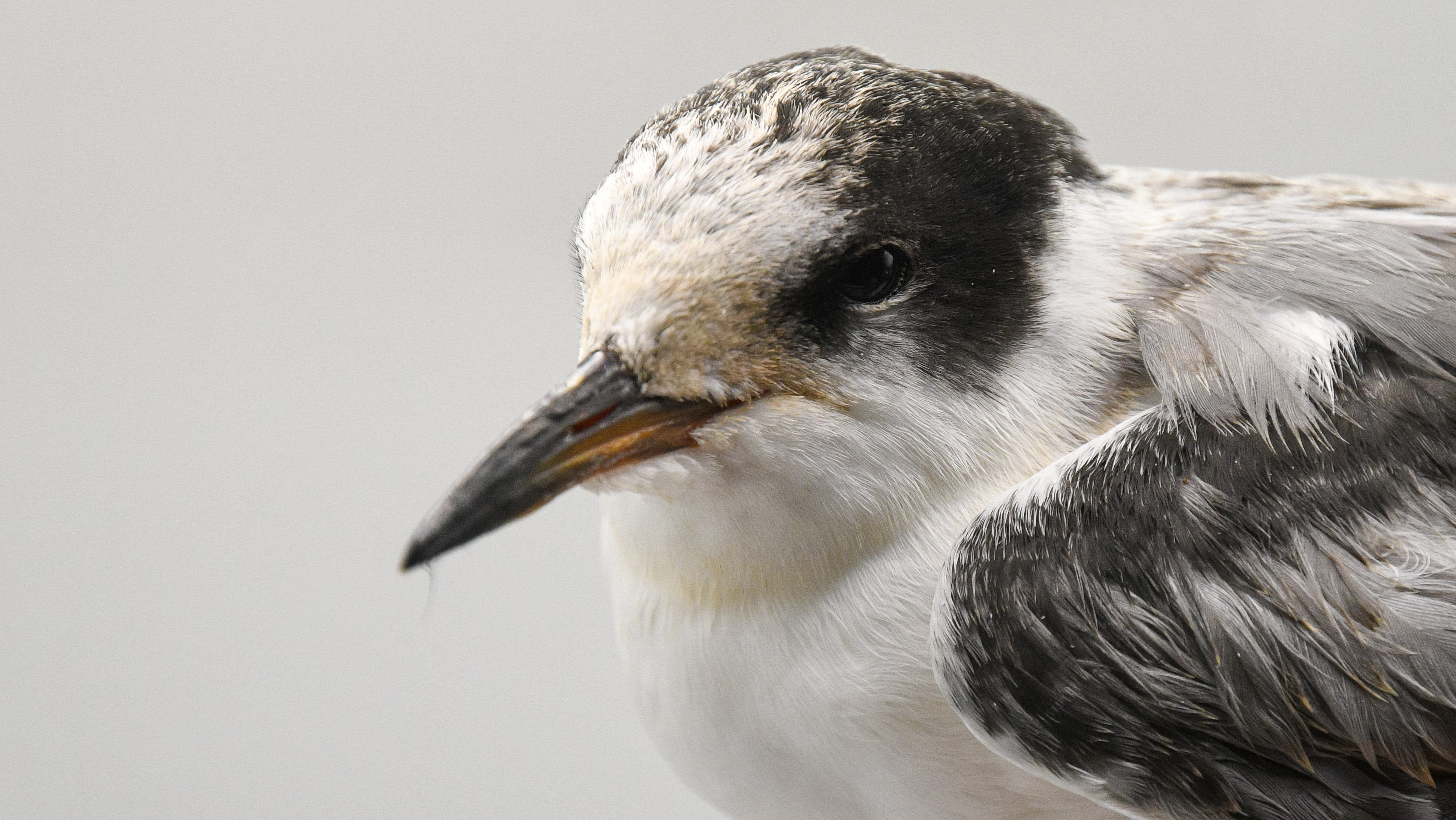
Since I was already awake, I spent the night with Johanna doing the checks. It was really nice to hear storys about previous volunteer life here. Some shooting stars could be seen in the sky.
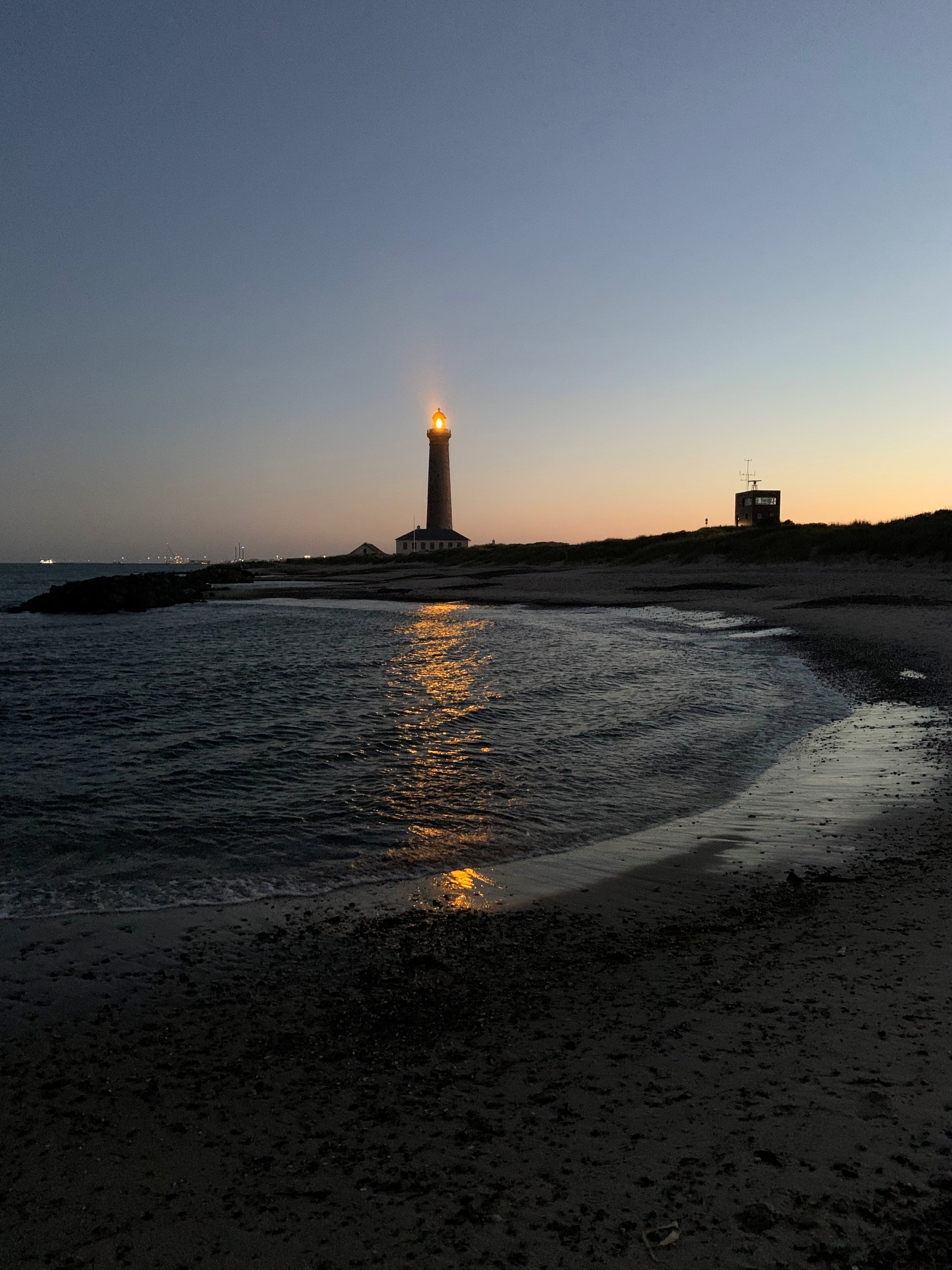
As it was already late, I went directly to World's End 3 to start the count, which was later continued by Knud in view of my lack of sleep. We again saw two roosting Parasitic Skuas (Almindelig Kjove), a few Fulmars (Mallemug) (fewer than yesterday) and an Manx Shearwater (Almindelig Skråpe).
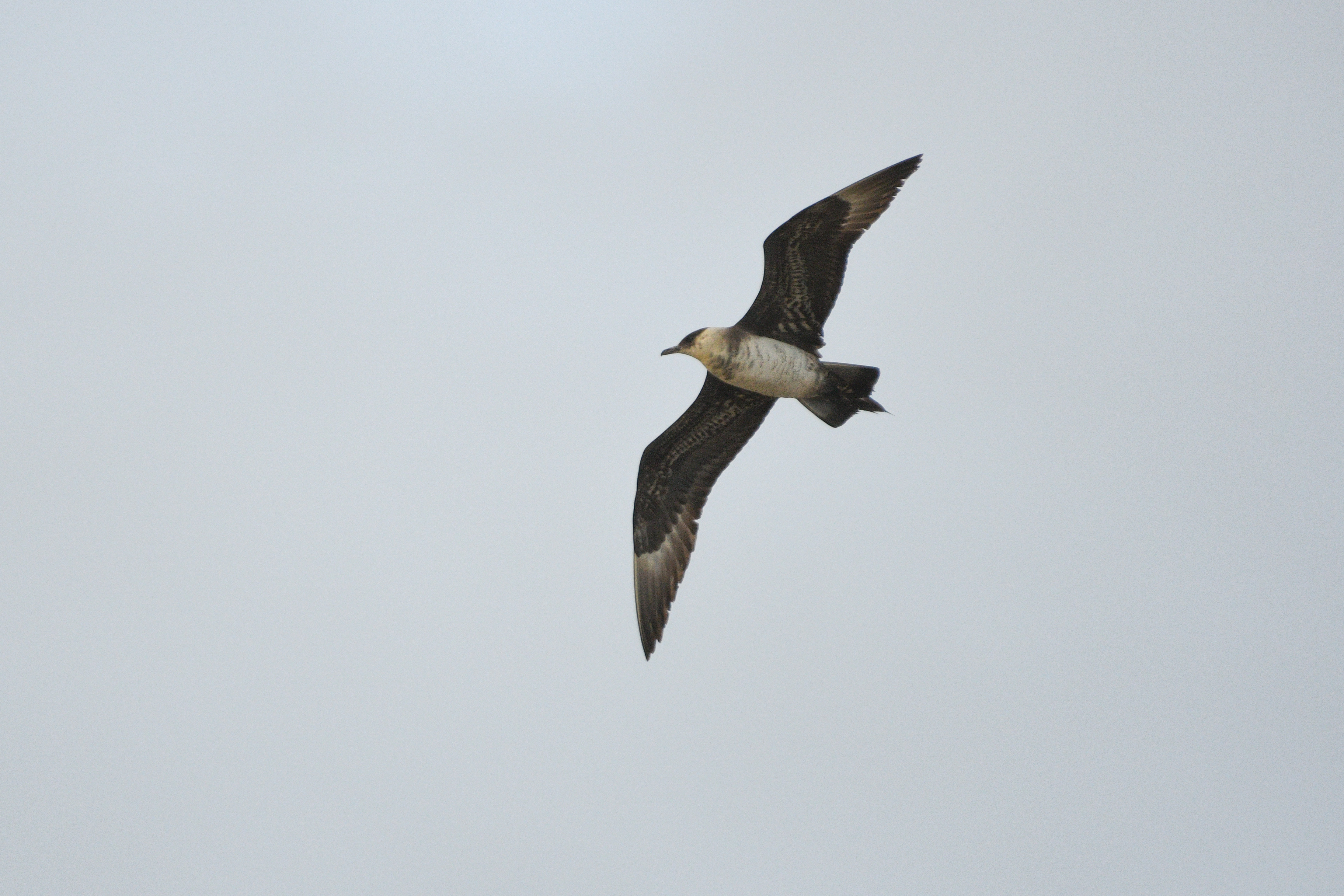
Then I went back and paused briefly to photograph the House Martins in front of the lighthouse.
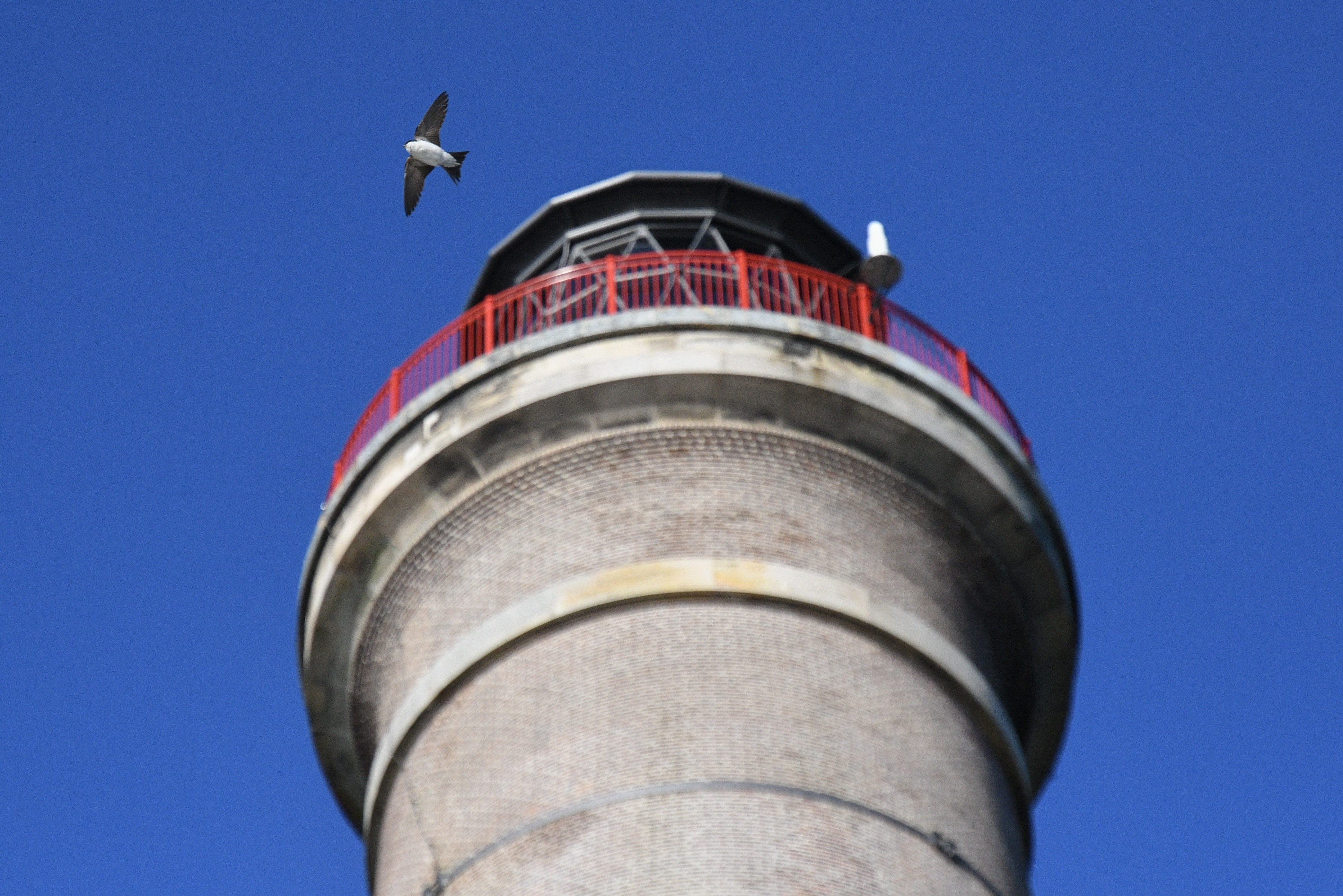
After that I had my sleep from 9 to 3pm. Meanwhile Bjørn and Martina were ringing at Kabeltromlen. There were not many birds on site, but a really cool species composition. The first bird of the day was this Water Rail (Vandrikse).
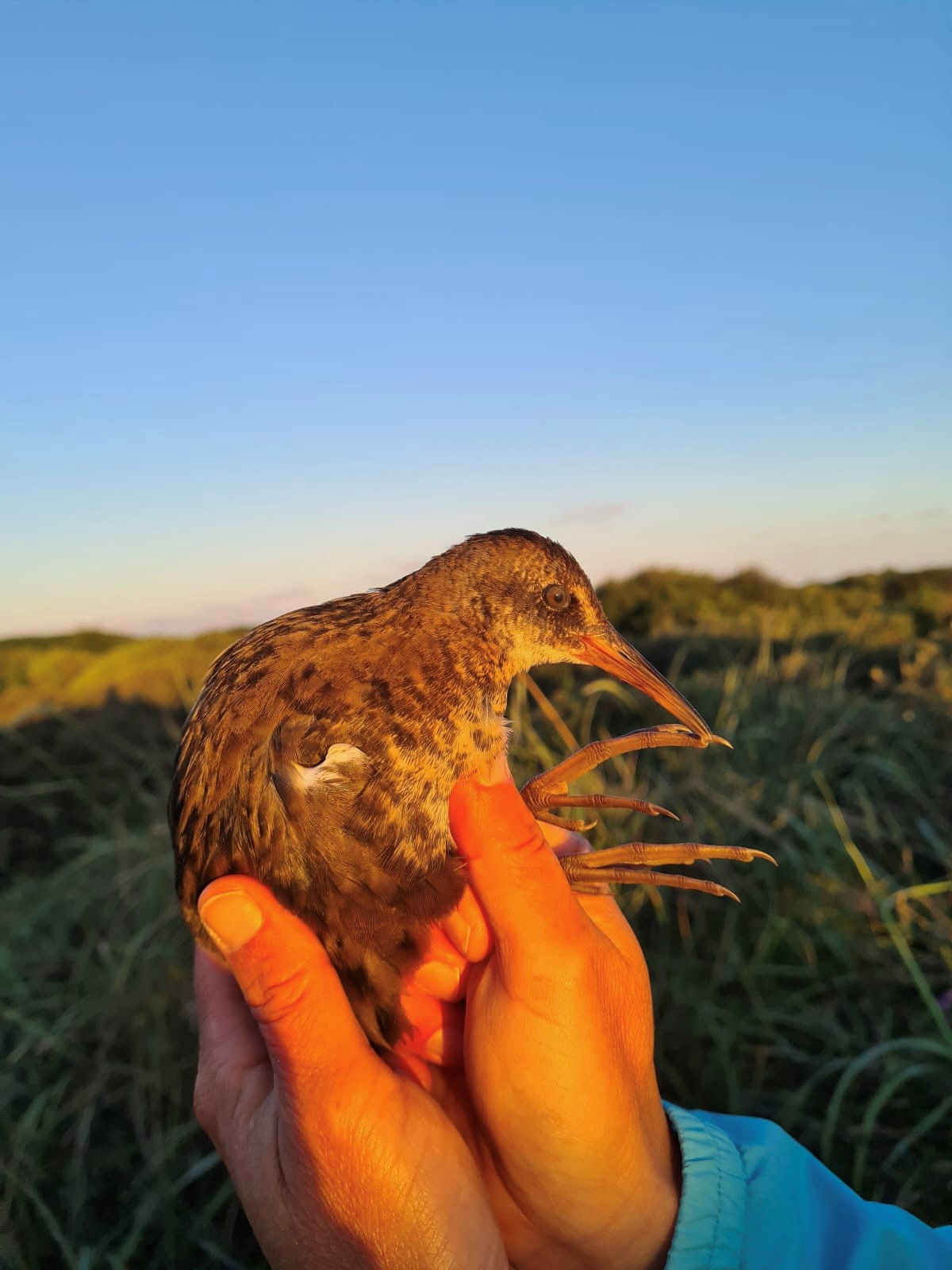
The afternoon was spent sleeping, evening meeting, shopping, cooking and reporting data. So the day (and night) was very successful with nice catches and slowly the songbird migration starts. I am already looking forward to the next nightcatching session.
Ringing (Grå Fyr)
Nightjar (Natravn) - 2
Common Tern (Fjordterne) - 1
Total: 3
Ringing (Kabeltromlekrattet)
Water Rail (Vandrikse) - 1
Wren (Gærdesmutte) - 1
Lesser Whitethroat (Gærdesanger) - 1
Common Redstart (Rødstjert) - 1
Chiffchaff (Gransanger) - 2
Icterine Warbler (Gulbug) – 1
Garden Warbler (Havesanger) - 1
Willow Warbler (Løvsanger) - 2
Blue Tit (Blåmejse) - 1
Marsh Warbler (Kærsanger) - 1
Total: 12
People: Martina Hillbrand, Simon Kiesé, Bjørn Laursen, Simon S. Christiansen, Lisa Vergin, Karen and Henrik Toft, Johanna Veentjer
A link to today's observations from volunteers and local observers.
